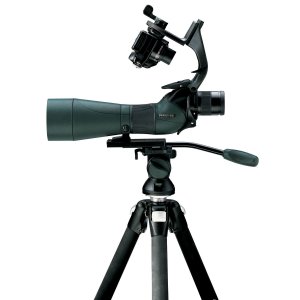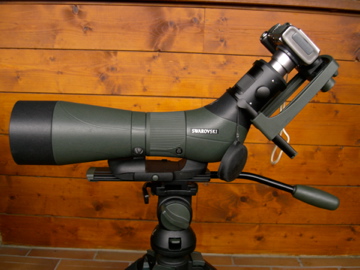Digiscoping is basically using a digital camera to take photos through a telescope. Initially, cameras were hand-held up to the telescope's ocular lens. While this works, the extra stability and alignment benefits of having an adapter mean that it is much easier to consistently take good photos when you have a good digiscoping adapter/camera mount.
I have used a good number of adapters and digiscoping setups over the years. Over the past few years, I have used the various Swarovski Optik digiscoping adapters extensively. And they all have their uses so I generally choose one depending on what I will be doing that day. But the digiscoping adapter that really stands out to me at the moment - and the one I invariably pack - is The New Universal Camera Adapter (the UCA).
The Swarovski Optik UCA has only just been reveled to the press (which is what the Kazakhstan trip was all about). I will write a proper write-up on the new UCA in the next few days, and I also have a video on its use. When it is done, I will post it here.
Essentially, the UCA has been designed to mount either a compact digital camera or a DSLR. The camera screws on to a little base plate using the camera's tripod thread, and this clips on to the mounting platform. The camera can be unclipped and slid off the platform easily so that you can use it separately, and when you slide it back on it clicks back in to place and does not need readjusting before taking a photo.
 The UCA has the great advantage of allowing me to use it with my compact camera, a camcorder, or a DSLR. You can also take it off and put it back on quickly; separate the camera from the adapter easily (without need for readjustment when replacing); and always have easy access to the eyepiece's zoom. It is also rather light, which is an added bonus.
The UCA has the great advantage of allowing me to use it with my compact camera, a camcorder, or a DSLR. You can also take it off and put it back on quickly; separate the camera from the adapter easily (without need for readjustment when replacing); and always have easy access to the eyepiece's zoom. It is also rather light, which is an added bonus.The new UCA has also come at a good time for my new interest in videoscoping. I'll post more videoscoping videos of birds over the next few weeks (including Longlegged Buzzard, Shorteared Owl, Himalayan Rubythroat, Pygmy Cormorants, Greater Flamingoes and much more).
 Videoscoping Pygmy Cormorants in Po Delta, Italy. Videoscoping setup is per digiscoping but with a Panasonic SD100 mounted on the UCA. Yes, that is a DCA on the counter.
Videoscoping Pygmy Cormorants in Po Delta, Italy. Videoscoping setup is per digiscoping but with a Panasonic SD100 mounted on the UCA. Yes, that is a DCA on the counter.I still use my DCA (the little ring digiscoping adapter you can see on the shelf in the hide photo, above), particularly if I know that I will be doing more observation birding than digiscoping, and if I have a pocket free. The DCA has the advantage of being small and pocketable when using a compact camera, but it does not fit all compact cameras because the camera needs to have a filter attachment thread/cone, and I don't find the scope's zoom as easy to use as with the other adapters.
 DCA attachment of a DSLR. The DCA has the advantage of being small, light and easy to use, and works for many compact digital and DSLR camera. The disadvantage being that not all compact cameras have a filter adapter cone, and with a DSLR, the camera is only attached via the filter thread.
DCA attachment of a DSLR. The DCA has the advantage of being small, light and easy to use, and works for many compact digital and DSLR camera. The disadvantage being that not all compact cameras have a filter adapter cone, and with a DSLR, the camera is only attached via the filter thread.The DCA was one of the first digiscoping adapters introduced on the market and has quite a fan-base among DSLR users as it allows you to quickly slip the camera on and off again. The downside of this adapter (solved in the UCA) is that the camera is attached using the camera's filter thread, which was not designed to hold the weight of heavy DSLRs. Having said that, with a small 40 to 50mm "pancake lens", and a little bit of care, the DCA works like a dream, and along with the Telescope Rail to shift the centre of gravity further forward and balance the whole setup, it really does make DSLR digiscoping easy.
If you have the DCA ring attached to your DSLR (or even your compact camera), you can very easily use this for digibinning, by sliding the swarovski optik snapshot adapter on to your binoculars and then just using the DCA ring to cup over the snapshot adapter. This creates a good attachment platform for taking a quick digibinning photo.
 The DCB flips up and out of the way when using the scope for birding/observation.
The DCB flips up and out of the way when using the scope for birding/observation.The photo is off the internet somewhere 'cos I cannot find one of mine anywhere on my computer. Maybe someday I will replace it with one of my own photos.
I know that the DCA has its strong (and rather vocal) supporters, but with a compact camera, I frankly prefer my DCB. The DCB is a bracket that lets me flip my camera in front of the scope's ocular and then back out of the way again. The camera sits nice and neatly up above the scope. I can then use the quick-release slide on the Telescope Rail to balance the scope properly again. I think I like this system so much because it keeps the camera out of the way, but I don't have find a pocket or bag to hold the camera when I am not using it. This is a great advantage when hiking out somewhere and I don't want to have to take a bag (or clothing with big pockets) with.
The other thing I like about the DCB is that I can use my 30x wide or a zoom eyepiece with it (the current DCA can also do this, but you need to use a little elastic/rubber band or something to wrap around the 30xW to make it a little broader, to help the adapter get a snug connection).
I have heard some digiscopers voice concern about having their camara always exposed to beach sand, rain, etc. I have never had a problem with this. If it is starting to drizzle, I put my hat over the camera. If the conditions are too bad, you can always just unclip and slide the camera off of the DCB and put it somewhere waterproof or dry. Unfortunately, when you want to put it back on again, you will need to find the correct position again manually, but I have never found this too much of a hassle.
The one thing that I don't particularly like about the DCB digiscoping adapter is that the camera is easily bumped from position, i.e. swivelled out of place. This is particularly the case if your camera's tripod thread is offset from the center, meaning that the connection plate would attach to one side. It certainly helps to make sure that the attachment plate is screwed tightly in, but the other thing you can do is to try to make the attachment place a little more adhesive with some thin elastic bands or by glueing a little bit of sticky silicon in place. It doesn't help to be careful with your camera and digiscoping setup either ;-)
Happy digiscoping and happy birding!
Dale
p.s. if you are interested in digiscoping, then check out our Digiscoping Today meme.






.JPG)



.jpg)








.jpg)




7 comments:
Thanks for this great explanation on digiscoping. I was totally ignorant about all this. May not be something I invest in right away. Why not just use a bigger better camera?
Interesting post on the use of a digiscope instead of a telephoto lens. To answer your question as to what I feed the hummingbirds. I just make a mixture of 1 part sugar to 4 parts water. The U.S. has a lot of different species of hummingbirds but the ruby throat is the only one east of the Mississippi River.
Hi Gaelyn, the simple answer is that I have a scope with me wherever I go anyway so digiscoping is a natural progression, and allows me to make up to an effective 2000mm telephoto lens and take decent photos therewith.
The other thing is the price. As I said, I have a scope anyway, and for a 600mm f4.0 telephoto lens you are looking at about $7600 US!
John, well, if you are going to get only one species, it might as well be one as gorgeous as the rubythroat!
Great article Dale - very informative - you really know your stuff.
Hey Dale, I can't wait to get into digiscoping! Very nice entry. Thanks for stopping by my place. I have pictures of the great warblers and you like the Tricolored Heron. That was a surprise.
Dave
Dave, are you serious? how could I not love Tricolored Heron! They are incredible!
Thank you for this post Dale. I've started getting interested in digiscoping of late and its hard to find a simple articles that have real info.
Post a Comment